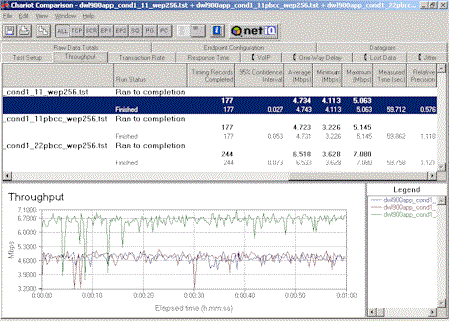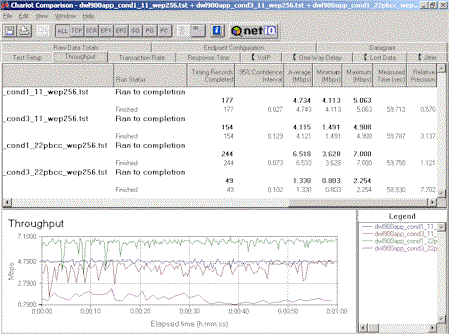Wireless Performance
NOTES:
• The units for the SNR readings above are Link Strength %, not Signal-to-Noise Ratio.
• Testing was done with a D-Link DWL-650+ Cardbus Adapter in a laptop running WinXP Home
This being my first test of an 802.11b product using the TI chipset and having a 22Mbps PBCC mode, I did a lot of extra testing, including one-minute test runs using NetIQ's Chariot. The results in the table above were done with the client set to a mode equivalent to that used when I test normal 802.11b products, i.e. 11Mbps auto-fallback.
NOTE! The AP automatically handles simultaneous connections using PBCC and standard 802.11b modes. I ran one of my Chariot tests with an AirPlus client in 22Mbps PBCC mode, while another standard 802.11b client was pulling a 20kbps Windows Media stream. Neither client had any problems.
The results show performance that's about what I'd expect from a good 802.11b setup. The toughest test was under Condition 3, which has the signal passing through only two sheetrock walls, but at a very sharp angle on both walls. Although I'd never realized it before, this makes the wall look much thicker to the signal, which probably accounts for the worst performance in this location. (This discovery was courtesy of the information in the User Manual, and also available on this D-Link FAQ page.)
The other good news is that there didn't appear to be any throughput penalty for enabling WEP, in either normal DSSS or the special PBCC modulation modes. The WEP key length didn't make any difference either. So there's really no excuse for not enabling WEP when using AirPlus products.
But how about the PBCC modes? What sort of performance boost do you get? That's where I turned to Chariot to get a good look.

The above screenshot (click on it for a full-sized view) shows a NetIQ Chariot Comparison result for three one minute throughput runs, using the Condition 1 (best case) setup: one in the 802.11b compatible 11Mbps mode, the second in11Mbps PBCC mode, and the third in 22Mbps PBCC mode. All runs had 256 bit WEP enabled. The results show very little difference between the normal 11Mbps and 11Mbps PBCC modes, but show a 38% throughput gain in 22Mbps PBCC mode. Although this result doesn't even meet my rule of thumb of half the manufacturer's spec (which would be 11Mbps), hey, 40% is 40%, so we'll take it!
But, unfortunately, there's a catch as the plot below shows.

This plot compares performance with Conditions 1 and 3, in normal 11Mbps and 22Mbps PBCC modes. In 11Mbps mode, you get about a 13% degradation in average throughput between the two conditions, but in 22Mbps PBCC mode, performance falls off a whopping 80%! So although speed may not kill, in this case it certainly will slow down your network.
One other observation is worth noting. While running my Condition 3 tests, I thought I noticed better performance in 11Mbps PBCC mode vs. normal 11Mbps mode. But when I used Chariot's comparison tool, I found that although the 11Mbps PBCC mode had a 5% higher average throughput, its Relative Precision value (which is based on the statistical Standard Deviation and Error calculations on the data sets) was also 7% higher. I'm not sure that these two percentages can directly be compared, but since a higher Relative Precision value means a less precise (or certain) result, you probably couldn't count on PBCC mode to reliably give you any performance advantage.
802.11b Wireless Performance Test Results
| Test Conditions - WEP encryption: DISABLED | Firmware/Driver Versions AP f/w: | ||||
|---|---|---|---|---|---|
| Test Description | Signal Strength (%) | Transfer Rate (Mbps) | Response Time (msec) | UDP stream | |
| Throughput (kbps) | Lost data (%) | ||||
| Client to AP - Condition 1 | 100 | 4.7 [No WEP] 4.8 [w/ WEP] | 2 (avg) 3 (max) | 443 | 0 |
| Client to AP - Condition 2 | 100 | 4.8 | 2 (avg) 3 (max) | 435 | 0 |
| Client to AP - Condition 3 | 61 | 2.2 | 2 (avg) 3 (max) | 285 | 0 |
| Client to AP - Condition 4 | 75 | 4.8 | 2 (avg) 3 (max) | 437 | 0 |